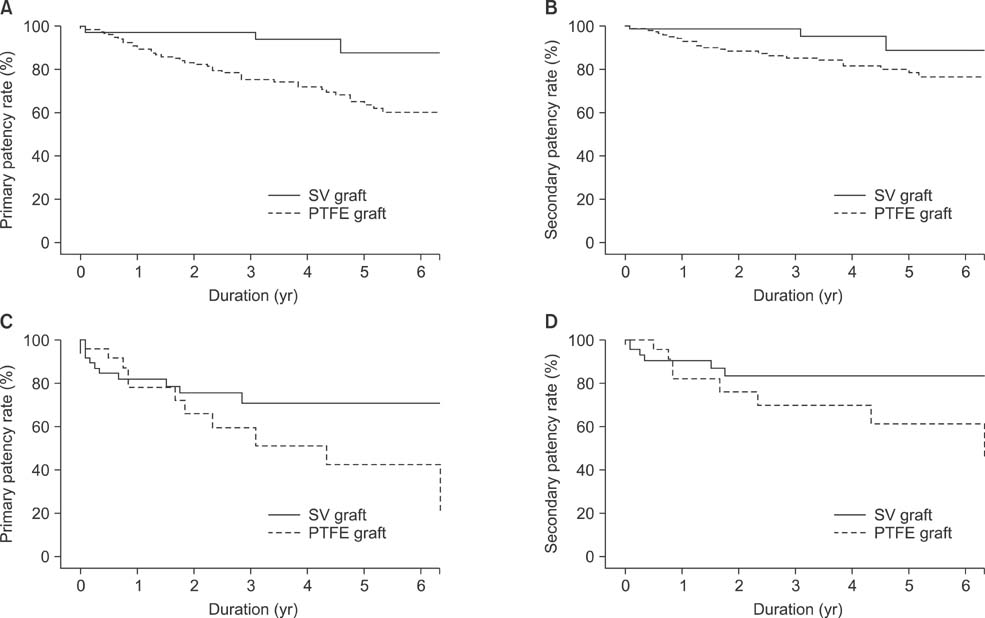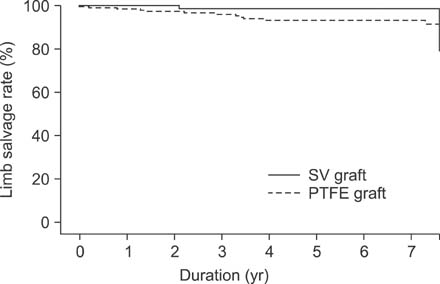Ann Surg Treat Res.
2014 Jul;87(1):35-40. 10.4174/astr.2014.87.1.35.
Comparisons between prosthetic vascular graft and saphenous vein graft in femoro-popliteal bypass
- Affiliations
-
- 1Division of Vascular Surgery, Samsung Medical Center, Sungkyunkwan University School of Medicine, Seoul, Korea. dikim@skku.edu
- KMID: 1804097
- DOI: http://doi.org/10.4174/astr.2014.87.1.35
Abstract
- PURPOSE
Infrainguinalfemoropopliteal bypass (IFPB) is recommended to peripheral arterial disease (PAD) with a long occlusion of the superficial femoral artery (SFA). The aims of our study were to determine the patency of graft materials, and identify the risk factors of graft failure.
METHODS
From January 1995 to April 2011, we had performed 380 IFPBs in 351 patients, including 302 femoro-above the knee (AK) bypasses and 78 femoro-below the knee (BK) bypasses. We compare age, sex, severity of ischemia between polytetra-uoroethylene (PTFE) graft and saphenous vein (SV) graft, and evaluate patency rate rates of the two groups.
RESULTS
The primary patency rates at 5 years for SV (n = 76 limbs) and PTFE grafts (n = 226 limbs) in AK were 85.2% and 64.5% (log rank = 0.03), and the secondary patency rates at 5 years for SV and PTFE grafts in AK were 88.2% and 79.0% (log rank = 0.13). The primary patency rates at 5 years for SV (n = 50 limbs) and PTFE grafts (n = 28 limbs) in BK were 63.2% and 40.0% (log rank = 0.08), and the secondary patency rates at 5 years for SV and PTFE grafts in BK were 71.6% and 55.5% (log rank = 0.18).
CONCLUSION
There was no statistical significant difference in secondary patency rates between SV and PTFE in IFPB. PTFE grafts as SV grafts can be a good alternative bypass material in IFPB instead of SV grafts.
Keyword
MeSH Terms
Figure
Reference
-
1. Norgren L, Hiatt WR, Dormandy JA, Nehler MR, Harris KA, Fowkes FG, et al. Inter-Society Consensus for the Management of Peripheral Arterial Disease (TASC II). Eur J Vasc Endovasc Surg. 2007; 33:Suppl 1. S1–S75.2. Bradbury AW, Adam DJ, Bell J, Forbes JF, Fowkes FG, Gillespie I, et al. Bypass versus Angioplasty in Severe Ischaemia of the Leg (BASIL) trial: analysis of amputation free and overall survival by treatment received. J Vasc Surg. 2010; 51:5 Suppl. 18S–31S.3. Twine CP, McLain AD. Graft type for femoro-popliteal bypass surgery. Cochrane Database Syst Rev. 2010; (5):CD001487.4. Kim DI, Huh SH, Lee BB. Vascular clips as a landmark for sites of anastomosis. Surg Today. 2003; 33:78–79.5. Berglund J, Bjorck M, Elfstrom J. SWEDVASC Femoro-popliteal Study Group. Long-term results of above knee femoro-popliteal bypass depend on indication for surgery and graft-material. Eur J Vasc Endovasc Surg. 2005; 29:412–418.6. Eifell R, Mudawi A. A simple technique to prevent graft kinking during tunneling of a reversed vein femoropopliteal bypass graft. Surg Today. 2007; 37:356–358.7. Inoue Y, Sugano N, Jibiki M, Kitamura S, Iwai T. Cuffed anastomosis for above-knee femoropopliteal bypass with a stretch expanded polytetrafluoroethylene graft. Surg Today. 2008; 38:679–684.8. Williams GT, Underwood CJ, Charlesworth D. Early results of femoropopliteal bypass using a five millimeter "thin wall" polytetrafluoroethylene (Gore-Tex) prosthesis. Ann Vasc Surg. 1986; 1:208–213.9. Veith FJ, Gupta SK, Ascer E, White-Flores S, Samson RH, Scher LA, et al. Six-year prospective multicenter randomized comparison of autologous saphenous vein and expanded polytetrafluoroethylene grafts in infrainguinal arterial reconstructions. J Vasc Surg. 1986; 3:104–114.10. Burger DH, Kappetein AP, Van Bockel JH, Breslau PJ. A prospective randomized trial comparing vein with polytetrafluoroethylene in above-knee femoropopliteal bypass grafting. J Vasc Surg. 2000; 32:278–283.11. Ruckert RI, Tsilimparis N, Lobenstein B, Witte J, Seip G, Storck M. Midterm results of a precuffed expanded polytetrafluoroethylene graft for above knee femoropopliteal bypass in a multicenter study. J Vasc Surg. 2009; 49:1203–1209.12. Park UJ, Kim DI. Thromboangiitis obliterans. Int J Stem Cells. 2010; 3:1–7.13. Kim DI, Kim MJ, Joh JH, Shin SW, Do YS, Moon JY, et al. Angiogenesis facilitated by autologous whole bone marrow stem cell transplantation for Buerger's disease. Stem Cells. 2006; 24:1194–1200.14. Cheng SW, Ting AC, Ho P. Angioplasty and primary stenting of high-grade, long-segment superficial femoral artery disease: is it worthwhile? Ann Vasc Surg. 2003; 17:430–437.15. Sabeti S, Mlekusch W, Amighi J, Minar E, Schillinger M. Primary patency of long-segment self-expanding nitinol stents in the femoropopliteal arteries. J Endovasc Ther. 2005; 12:6–12.16. Ihnat DM, Duong ST, Taylor ZC, Leon LR, Mills JL Sr, Goshima KR, et al. Contemporary outcomes after superficial femoral artery angioplasty and stenting: the influence of TASC classification and runoff score. J Vasc Surg. 2008; 47:967–974.17. Klinkert P, Post PN, Breslau PJ, van Bockel JH. Saphenous vein versus PTFE for above-knee femoropopliteal bypass. A review of the literature. Eur J Vasc Endovasc Surg. 2004; 27:357–362.18. Pereira CE, Albers M, Romiti M, Brochado-Neto FC, Pereira CA. Meta-analysis of femoropopliteal bypass grafts for lower extremity arterial insufficiency. J Vasc Surg. 2006; 44:510–517.19. Prendiville EJ, Yeager A, O'Donnell TF Jr, Coleman JC, Jaworek A, Callow AD, et al. Long-term results with the aboveknee popliteal expanded polytetrafluoroethylene graft. J Vasc Surg. 1990; 11:517–524.20. Rosenthal D, Evans RD, McKinsey J, Seagraves MA, Lamis PA, Clark MD, et al. Prosthetic above-knee femoropopliteal bypass for intermittent claudication. J Cardiovasc Surg (Torino). 1990; 31:462–468.
- Full Text Links
- Actions
-
Cited
- CITED
-
- Close
- Share
- Similar articles
-
- Comparison of Surgical Outcomes between Reversed Vein Graft and Prosthetic Graft in Above-knee Femoropopliteal Bypass
- Effects of Distal Anastomotic Vein Cuff or Patch on Below-Knee Leg Arterial Bypass with Ringed Polytetrafluoroethylene (PTFE) Graft
- Popliteal-to-Dorsalis Pedis In-Situ Small Saphenous Vein Bypass under Planning with Mapping Using Computed Tomography Volume Rendering Technique
- Comparison of Surgical Outcomes between Below-knee Femoro-popliteal and Femoro-infrapopliteal Bypasses after Using Autologous Reversed Saphenous Vein Graft
- Results of Bypass Surgery in Patients with Atherosclerosis Obliterans of the Lower Extremities



